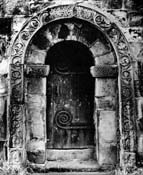Select a site alphabetically from the choices shown in the box below. Alternatively, browse sculptural examples using the Forward/Back buttons.
Chapters for this volume, along with copies of original in-text images, are available here.
Object type: Two imposts, now re-faced [1]
Measurements:
a (west side impost, east face):
H. 13.5 cm (5.3 in); W. 25 cm (9.8 in) top > 24 cm (9.5 in) bottom
b (east side impost, west face):
H. 14 cm (5.5 in); W. 27 cm (10.6 in) top > 26 cm (10.2 in) bottom
Stone type: Original pieces: sandstone, yellowish-brown, fine- to medium -grained, quartzose with feldspars poorly cemented. Some pieces show parallel lamination. Carboniferous. See Ledsham (All Saints) 1. Later replacements are more reddish-brown and coarser-grained, with occasional granules of quartz. [G.L.]
Plate numbers in printed volume: Ills. 462-6
Corpus volume reference: Vol 8 p. 196-7
(There may be more views or larger images available for this item. Click on the thumbnail image to view.)
As suggested above, the front (south face) of both imposts is a modern replacement (Ill. 462), 'with ugly misunderstood patterns and an extremely curved surface' (Adcock 1974, I, 75). However, complete runs of pattern survive on the inner faces. Both are edged with a flat outer moulding and inner roll moulding. The fine strands, which are about one-third width and which are high and rounded, are relieved against a smoothly dressed background. Adcock attributed the slightly curved appearance of the original sections to the stepping back of the lower moulding, a feature she also found in early Anglo-Saxon work from Monkwearmouth. The two patterns are different: that on the eastern impost (Ills. 465–6) is an alternate pattern C with one outside strand; that on the western impost (Ills. 463–4), an 'interlocked' wide pattern E.
Adcock (1974, I, 76–7) noticed the care taken over the pairing of these two patterns. Both are five-cord patterns with uneven numbers of strands, and both have what she describes as an 'alternate sway in their elements'. Both have a unit measure of 3.5 cm. Five-cord patterns seem to be extremely rare, but Adcock related this to a design she reconstructed from two fragments of lead found at Monkwearmouth, not only in the pattern C elements but in the experimental approach (ibid., I, 72, fig. 20a, II, pl. 4; see now Cramp 2006b, 51, fig. 26.6.17) . The pattern E seems to be unique, although she pointed to an inlaid glass ornament from Whitby with a similar theme (Webster and Backhouse 1991, ill. 107n). The fine single strand in both patterns she compared to the 'knitting stitch' pattern in a similar technique from Ingleby Arncliffe, north Yorkshire (Lang 2001, 125, no. 1, ill. 325), which Lang himself compared to a pattern on a cross-shaft from St Leonard's Place, York (Lang 1991, 109–10, no. 2, ills. 369–72). Adcock also related both interlace faces of this York shaft to the Ledsham imposts (1974, I, 77, 228, II, pl. 97a–b). Lang dated both the Ingleby Arncliffe and the York pieces to the ninth century. Adcock pointed out, however, that the 'knitting stitch' is found in early metalwork, for example it appears in a prominent position on the Sutton Hoo buckle (Webster and Backhouse 1991, ill. 15); and that all these pieces, including three fragments from Hexham (Cramp 1984, nos. 9, 12 and 30, pls. 176.928–32, 178.944–5, 184.1000), the Northallerton cross-head (Lang 2001, 182, no. 5, ills. 672–6); and a cross-head from Carlisle (Bailey and Cramp 1988, 84, no. 1, ills. 196, 198–201), relate to a style of carving very closely imitating fine filigree work and with a number of common pattern elements, including the 'marigold' pattern (see Ledsham 3 above), and all linked to the monasteries of Ripon and Hexham by distribution. The pieces in question have been variously dated, from the late seventh to the early eighth century (Carlisle 1, Hexham 9 and 30); late eighth to ninth century (Hexham 12); and ninth century (Ingleby Arncliffe 1, Northallerton 5). The stylistic relationship is important and links to a larger question regarding the pre-eminency of metalwork models, which will also be discussed in relation to sculpture from Ripon itself (see Ripon 2, p. 234). In the case of Ledsham, it seems clear that the doorway is part of the earliest church at the site, and that the inner faces of the imposts are original (see also Ledsham 3 above): an early date for these pieces is therefore proposed.



